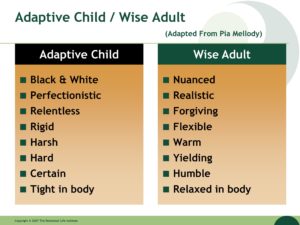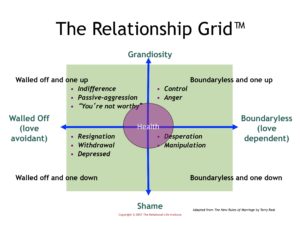The 20 Relationship Practices are extracted from Terry Real‘s book “The New Rules of Marriage“. It is the deliberate cultivation of a mindfulness practice of brining the wise adult part of ourselves into relationship with the adaptive child parts of ourselves over and over again. Relationship practice occurs at the micro level, minute by minute, to interrupt our knee-jerk reaction and offer a more constructive learned alternative. Growing this wise adult part of ourselves, arming it with tools, and strengthening its power to override automatic reactions is the essence of relationship practice.
The Relationship Grid is a tool to know where we are and our health level of self-esteem (vertical line) and boundary (horizontal line). Health is in the middle. To step into deep connection and become fully intimacy ready with one another, both partners need to learn and master the skills of healthy self-esteem and good boundaries.
1. Appreciating
- Appreciate each other at least once a day. At the end of the day, tell your partner three things you appreciate, either about something current or something more long-standing. “I really appreciate your listening to me earlier this evening” is one example. But so is “You have always had the most beautiful eyes.”
- Develop “an attitude of gratitude.” Throughout the day, notice and shift all victim thinking. If you don’t like something, change it, leave it, or embrace it. If you choose to neither change nor leave, then own your choice and appreciate the good qualities in the situation.
2. Boundary Practice
- Take a moment to visualize setting your boundaries at the beginning of each day. Throughout the day, take a moment to reset them through visualization. Take stock of where you might be at a given moment and correct if necessary, softening walls and strengthening appropriate containment and protection.
- Avoid all boundary-violating behaviors by staying on your side of the line. Speak from the “I,” not the “you” or the “it.” Remember, there is nothing that you need to say that cannot be said from the “I” with practice.
3. Cherishing
- Cherishing is the deliberate cultivation of your capacity to take pleasure in and celebrate what you have. Cherishing your partner’s progress by giving him specific positive feedback is the best way to engender more of the behaviors you’d like.
- You cherish your relationship by making time for it putting energy into it, and by giving your partner gifts in word and deed that demonstrate your care.
- You cherish yourself through active self-care.
- You cherish your commitment to continued growth and relationship practice by becoming partners-in-health, sharing information and inspiration.
- And you cherish abundance by stepping into your particular passions and gifts with no attempt to either own or disown them, but rather with joy and respect for your own success and a wish to contribute to the world.
4. CNI-Busting Behaviors
CNI are your Core Negative Images of your partner. With your partner, draw up a list of CNI-confirming and CNI-busting behaviors – behaviors that are like or very much unlike your partner’s negative expectations, or core negative image, of you. This list serves as your relationship compass, as specific operating instructions for how best to please your partner. Decrease CNI-confirming behaviors and increase CNI-busting behaviors.
5. Coming to Center
Use the relationship grid to provide a snapshot of where you are, and correct for any imbalance by doing self-esteem and boundary work.
6. Contracting
Making explicit contracts protects you, the contractor, in two ways, by:
- Making it difficult for the other person to take a victim position, since he’s agreed to the contract
- Making each other’s expectations and commitments clear
Contracts always concern behaviors, not attitudes or feelings, and are best when they are specific and close-ended.
7. Cultivating a Sense of Abundance
In both ordinary moments and, especially, in moments of upset, stop, either look down or close your eyes for a few seconds, and breathe. Feel the sweetness of a good, deep breath. Feel the warmth or coolness of the air on your skin. Feel the beauty of your surroundings, the sun, or the sight of trees outside the window. Remember that your life is abundant, that this moment is abundant, and that a particular disruption in your relationship or your circumstances will not take that abundance away.
8. Daring to Rock the Boat
In even the healthiest of relationships, getting what you want often involves assertively going after it. If something is important to you, and your partner doesn’t “get it,” you may need to stand up for your wants and needs by fighting for them. This means being willing to behave in ways that your partner will be uncomfortable with – acting as unhappy as you are about the issue, and, while remaining moderate and respectful, not backing down.
9. Dead-Stop Contracts
A dead-stop contract is an agreement to interrupt the vicious cycle of CNI-meets-CNI. The agreement goes like this: “If I feel, rightly or wrongly, that you are behaving in ways that reinforce my CNI of you – if I feel, for instance, that old, horrible feeling of being bossed around by you – I will signal a dead-stop. And you promise in advance that if you hear that signal, understanding that your behavior is CNI-triggering, you will come to a dead stop – whether you agree with my perception or not.”
When you use a dead-stop contract, nothing short of physical safety takes precedence over your goal of stopping your repetitive pattern, no matter what you think of your partner’s perception or motivation.
10. Helping Your Partner Succeed
Once your partner has responded by acknowledging and giving, you:
- Appreciate what you’ve been offered
- Ask what you might do to help
If your partner describes something you might do differently, it is now your turn to acknowledge and give what you can.
11. Listening to Understand
Remember, the speaker role and the listener role are two different roles. As the listener, listen. Focus on your partner and not on your rebuttals, explanations, or concerns, either spoken or merely thought. Turn points of connection into points of curiosity.
12. Making Requests
Instead of focusing on what your partner has done wrong, discipline yourself to focus on what he could do now or later that would be right. You shift from a negative/past focus to a positive/future focus.
Don’t criticize – ask!
13. Meeting Immaturity with Maturity
On those occasions when your partner is obviously operating from an immoderate, childish part of himself, hunker down and stay moderate yourself. Try two or three times to help your partner reseat himself in his functional adult self, as in, “Honey, I’m sorry. I really didn’t mean to put you down. All I meant was…” If, after a few such efforts, it becomes clear that your partner is simply behind a wall and not listening, politely and respectfully disengage. Don’t bother getting indignant or hurt, but also stop banging your head against the wall. Don’t argue, reason, or cajole. Just let go and give your partner space to figure it out.
14. Remembering Love
Before bringing up a difficult topic, recall that the person you’re about to speak to is someone you care about and that your goal in speaking is to make things better. Keep your eyes on the prize!
15. Responding with Generosity
Remember that in the repair process, the respondent’s only goal is to help your partner move back into harmony. You are “at his service.”
Your response is a two-step process. You:
- Acknowledge all that you can of what your partner has said
- Give all that you can of what your partner has asked for
When responding, lead with agreement, not argument.
16. Responsible Distance Taking
In contrast to unilateral, or provocative, distance taking, responsible distance taking always includes two elements:
- An explanation
- A promise of return or a proposed alternative
You don’t simply say, “I don’t want to talk,” you say, “I don’t want to talk right now. Here’s why, and here’s when I can.”
Anytime you say no to someone, you are taking distance, and should do so responsibly.
17. Self-Esteem Practice
Check to see where you are – one-down, one-up, or same-as.
- In your mind’s eye, go up if you are in a one-down, toxic shame state and visualize pulling yourself up into your body so that you look squarely out of your eyes at the other person, from a level, same-as, position.
- In your mind’s eye, go down if you are in a one-up, grandiose state and visualize pulling yourself down into your body so that you are looking squarely at the other person, from a level, same-as position.
18. Smart Generosity
Giving your partner more of what he’s asking for by asking yourself, “What will giving this cost me?” Things that aren’t difficult to give but that mean a lot to your partner, such as remembering an important date, admitting when you were wrong, or agreeing to do something you intended to do anyway, are low-cost, high-yield investments.
19. Time-Outs
When either partner calls a time-out – by saying the word “time-out,” by using the “T” hand signal, or by using any agreed-upon sign – the interaction comes to an immediate stop. The spoken or gestured signal is understood by both partners to be an abbreviation of the following words:
- “Dear partner, for whatever reason, right or wrong, I am about to lose it. If I stay here and keep this up with you, I am liable to do or say something stupid that I know I’m going to regret. Therefore I am taking a break to get a grip on myself and calm down. I will check back in with you responsibly.”
The default interval for a time-out is twenty minutes. Checking in does not necessarily mean getting back together. You can check in – either in person or by telephone – and tell your partner that you need more time. With each extension, the time-out interval gets longer. The recommended length between check-ins is:
- Twenty minutes
- One or two hours
- Half a day
- A whole day
- Overnight
When reconnecting after a time-out, you must take a 24-hour moratorium on the subject that triggered the initial fight.
20. Using the Feedback Wheel
- Contract with your partner to do the process; don’t just dump.
- Remember Love.
- Use the four steps of the feedback wheel:
- What I saw or heard
- What I made up about it
- How I feel about it
- What I’d like
- Let go of outcome.


